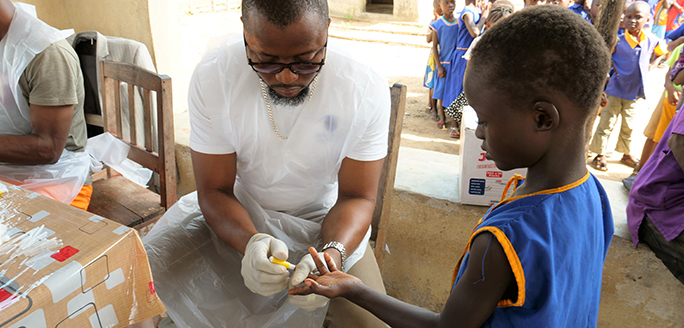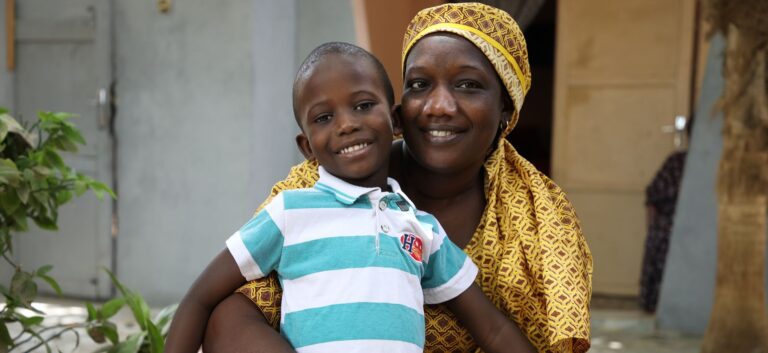Eliminating a Disfiguring Disease in Sierra Leone
In Sierra Leone, mosquitos are much more than a nuisance – they also transmit harmful diseases like lymphatic filariasis.
Known as LF for short, elephantiasis in the United States, and big fut in Sierra Leone, lymphatic filariasis is a disfiguring, centuries-old disease. The parasitic worms that cause LF are transmitted to humans through the bite of a mosquito carrying the parasite’s larvae. The infection damages the lymphatic and immune systems. While some people can harbor the disease for years without experiencing any symptoms, others suffer from abnormal enlargement of body parts, which causes pain and disability.

In Sierra Leone, LF is endemic nationwide. This may seem discouraging, but there is good news. LF is preventable, and great strides are being made in the global fight to eliminate the disease as a public health threat. USAID’s Act to End NTDs | West program (Act | West) is supporting this inspiring effort in 11 countries, including Sierra Leone, where Helen Keller International is the lead implementer of the project. Here’s a look at how.
“I Thought it Came from God”: Mabinty’s Story
Many people who suffer from LF have no idea what causes it. This is complicated by the fact that symptoms can appear many years after initial infection. That was the case for Mabinty Kalokoh, a 30-year-old woman who lives in a small village in the northern district of Bombali.

About 15 years ago, Mabinty developed a fever for no discernable reason. Then one morning, she woke up in pain, with swelling in her right foot. “I don’t know how I got it. I thought it came from God,” she said. She went to a traditional healer for treatment, but the medicine he gave her had no effect. By this time, the swelling had spread to her right leg. It was only then that she went to a doctor, who diagnosed her with LF and gave her medication to kill the parasite and prevent her symptoms from getting worse.

Above: During the dry season, the swelling in Mabinty’s leg is less visible and painful, and she is able to work.
But the irreversible damage caused by the disease continues to disrupt her life. “During the dry season, I can work,” she said. “But during the rains, when there’s plenty of water, I can’t move. When I fall sick, I have an attack of fever and pain, and I have no appetite.” During those times, she finds it hard to eat, and her foot gets so big that it will not fit into her shoe.
Stopping the Spread of New Infections

There is no way to fully cure Mabinty, but there is a highly effective way to stop the spread of new LF infections. Doing so in a comprehensive, sustainable way results in elimination of the disease as a public health problem.
In Sierra Leone, through the Act | West program, led by FHI 360, Helen Keller International supports the Ministry of Health and Sanitation in its efforts to control and eliminate LF across the country. The program provides funding and technical assistance for the Ministry’s LF elimination interventions; it also monitors and supervises these interventions.
The cornerstone of the LF elimination effort involves annual mass drug administrations (MDAs) to entire at-risk populations to stop the spread of LF. The drugs, ivermectin and albendazole, are donated to the Act | West partnership by the Mectizan Donation Program and GlaxoSmithKline and provided free of charge to communities in all 14 districts of Sierra Leone.
To reduce levels of infection, the drugs are administered on a yearly basis to all members of at-risk communities. Reaching a large enough proportion of the population consistently with MDAs kills adult parasites in infected individuals who have taken the medicine, so no more microfilariae, or “baby parasites,” can be produced and those people can no longer transmit the disease.
After just 5 years of annual MDAs, it is possible to reduce infections to a level that precludes disease transmission in entire communities, regions, and even countries.
To increase participation in the MDAs, Act | West produces a diverse range of outreach materials including posters, radio programs, and videos in local languages that educate the public about the importance of MDAs. We have seen a marked increase in awareness and participation as a result.
After at least 5 years of annual MDAs, Act | West organizes and conducts rigorous assessments to determine the prevalence of LF in the targeted communities. If the data show few or no positive LF cases, it is safe to stop the annual MDAs and shift into a period of close monitoring to ensure that the disease does not re-emerge.
Once a country maintains an LF prevalence rate of close to zero for at least 4 years, the country can apply to the World Health Organization (WHO) for official validation of elimination of LF as a public health problem. In 2017, Togo became the first sub-Saharan country in Africa to attain this remarkable achievement. Meanwhile, Sierra Leone has made considerable progress toward elimination: the government has stopped MDAs in 9 out of 14 districts, which are now in the monitoring stage.
Lymphatic Filariasis Will Become a Distant Memory
Fabiana is a community in the district of Bo. The area was once considered an LF hot-spot, but after 5 years of successful MDAs, Fabiana now has a prevalence rate of zero and is more than halfway through the surveillance period necessary for declaring elimination.

Helen Keller International’s Act | West survey team traveled to Fabiana in late March to conduct an LF prevalence assessment among schoolchildren ages 6 and 7. Before the test, the assessment leader, Beah Lebby, said, “Community health workers have done a good job distributing the drugs to the people, and the people have done a good job of complying and taking the drugs. We are not expecting to have any transmission.”
Nevertheless, the kids lined up in neat rows seemed apprehensive – not about the possibility of testing positive for LF, but about what might await them at the front of the line.
Usually, an assembly of nearly 100 kids would be hard to wrangle and raise quite a din, but this group stood silently, patiently inching forward child by child until they reached the table where Lebby gave each a quick finger prick test.

Only one child cried; the rest stoically extended their fingers for the test. All were rewarded with small packages of biscuits and cotton balls to hold proudly against their fingers.

The test results confirmed Lebby’s optimistic appraisal. For the second time, the assessment in Fabiana showed no new LF infections, once again qualifying the community as transmission-free.
According to WHO’s most recent analysis, Sierra Leone has achieved effective MDA coverage across 100 percent of the geographic area that requires it. The country is well on its way to eliminating LF as a public health problem. As an Act | West partner, HKI will continue working tirelessly with the Government of Sierra Leone to reach that milestone, so that LF – and the needless suffering of people like Mabinty – become a distant memory.
*USAID’s Act to End NTDs | West program, led by FHI 360, aims to control or eliminate seven of the most prevalent neglected tropical diseases in 11 countries across West and Central Africa. The consortium of partners includes Helen Keller International, Health Development International, Deloitte, World Vision, Americares and the AIM Initiative.



